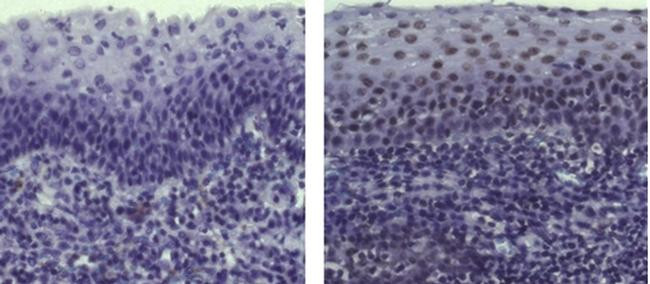Search Thermo Fisher Scientific
Invitrogen
Goat anti-Armenian Hamster IgG (H+L) Secondary Antibody, Biotin, eBioscience™
FIGURE: 1 / 2
Armenian Hamster IgG (H+L) Secondary Antibody (13-4113-85) in IHC (P)


Product Details
13-4113-85
Western Blot (WB)
Immunohistochemistry (Paraffin) (IHC (P))
Flow Cytometry (Flow)
ELISA (ELISA)
Species Reactivity
Host/Isotype
Class
Type
Conjugate
Form
Concentration
Purification
Storage buffer
Contains
Storage conditions
Shipping conditions
RRID
Target
Antibody Form
Product Specific Information
Description: This Anti-Armenian Hamster IgG antibody reacts with the heavy chains on Armenian hamster IgG and with the light chains common to most Armenian hamster immunoglobulins. Reactions to non-immunoglobulin hamster proteins have not been detected.
Applications Reported: In conjunction with enzyme- or fluorochrome-conjugated Streptavidin (SAV), this polyclonal antibody can be used for detection of purified Armenian hamster immunoglobulins (IgG) in ELISA, immunoblotting (WB), immunohistochemical staining and flow cytometry. At high concentrations, cross-reaction to Syrian hamster IgG has been observed.
Applications Tested: Biotin Anti-Armenian Hamster IgG has been tested by flow cytometric analysis to detect purified Armenian hamster monoclonal antibodies. This can be used at less than or equal to 1 µg per test. A test is defined as the amount (µg) of antibody that will stain a cell sample in a final volume of 100 µL. Cell number should be determined empirically but can range from 10^5 to 10^8 cells/test. It is recommended that the antibody be carefully titrated for optimal performance in the assay of interest. In addition, it has been adsorbed and tested by ELISA to ensure minimal cross reaction to human, bovine, rabbit, rat, and mouse serum proteins, but may cross-react with immunoglobulins from other species.
Filtration: 0.2 µm post-manufacturing filtered.
Target Information
Anti-Hamster secondary antibodies are affinity-purified antibodies with well-characterized specificity for hamster immunoglobulins and are useful in the detection, sorting or purification of its specified target. Secondary antibodies offer increased versatility enabling users to use many detection systems (e.g. HRP, AP, fluorescence). They can also provide greater sensitivity through signal amplification as multiple secondary antibodies can bind to a single primary antibody. Most commonly, secondary antibodies are generated by immunizing the host animal with a pooled population of immunoglobulins from the target species and can be further purified and modified (i.e. immunoaffinity chromatography, antibody fragmentation, label conjugation, etc.) to generate highly specific reagents.
For Research Use Only. Not for use in diagnostic procedures. Not for resale without express authorization.

Performance Guarantee
If an Invitrogen™ antibody doesn't perform as described on our website or datasheet,we'll replace the product at no cost to you, or provide you with a credit for a future purchase.*
Learn more
We're here to help
Get expert recommendations for common problems or connect directly with an on staff expert for technical assistance related to applications, equipment and general product use.
Contact tech support
